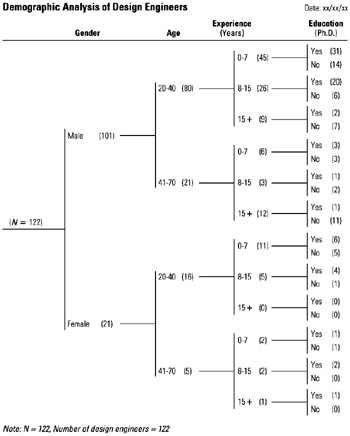Tool 22: Breakdown Tree
| AKA | Sample Analysis |
| Classification | Analyzing/Trending (AT) |
Tool description
A breakdown tree is used in statistical analysis when population or sample variables need to be displayed and analyzed. Using the breakdown tree format, variables and their respective frequencies, subgroups, and category headings can be easily illustrated.
Typical application
-
To break down population or sample variables into more defined subgroups.
-
To format data for the purpose of profiling or describing relationships.
-
To display data in the descriptive analysis section of statistical reports.
Problem-solving phase
| Select and define problem or opportunity | |
| → | Identify and analyze causes or potential change |
| Develop and plan possible solutions or change | |
| Implement and evaluate solution or change | |
| → | Measure and report solution or change results |
| Recognize and reward team efforts |
Typically used by
| 1 | Research/statistics |
| Creativity/innovation | |
| Engineering | |
| Project management | |
| Manufacturing | |
| 2 | Marketing/sales |
| 3 | Administration/documentation |
| Servicing/support | |
| Customer/quality metrics | |
| Change management |
before
-
Demographic Analysis
-
Audience analysis
-
Sampling Methods
-
Tree Diagram
-
Data collection strategy
after
-
Pie Chart
-
Polygon Overlay
-
Pictograph
-
Snake Chart
-
Bar Chart
Notes and key points
-
Do not break down data to fewer than five respondents or units of analysis.
-
Report frequencies (in parentheses) rather than percentages. Optional. A frequency distribution table can be constructed showing relative frequency (percent) for listed variables.
Step-by-step procedure
-
STEP 1 The researcher organizes and summarizes demographic response data by category and/or variables. See example Demographic Analysis of Design Engineers.
-
STEP 2 A tree diagram is drawn with branches representing categories and variables.
-
STEP 3 Frequencies (in parentheses) are inserted at respective branches of the breakdown tree.
-
STEP 4 All data entries are checked for accuracy by totaling all columns. In this example, they should add up to 122.
-
STEP 5 The chart is dated and used in various reports.
Example of tool application

EAN: 2147483647
Pages: 326
- Integration Strategies and Tactics for Information Technology Governance
- Linking the IT Balanced Scorecard to the Business Objectives at a Major Canadian Financial Group
- Measuring and Managing E-Business Initiatives Through the Balanced Scorecard
- Measuring ROI in E-Commerce Applications: Analysis to Action
- The Evolution of IT Governance at NB Power